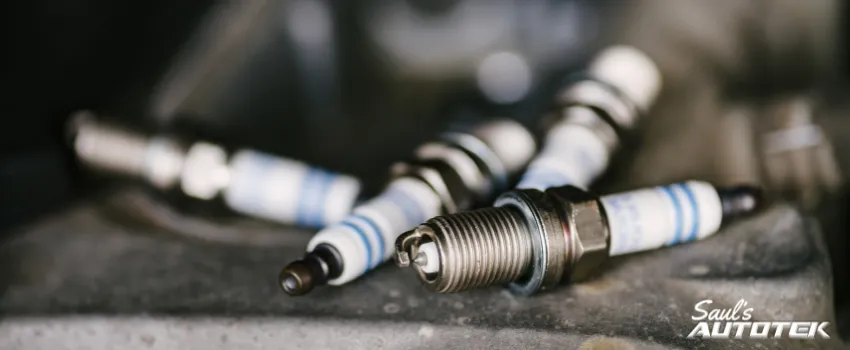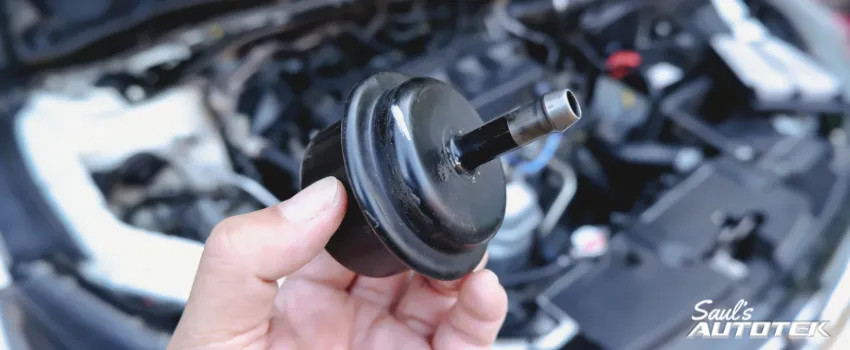Good morning. I’m Saul Reisman, and we’re going to keep taking a look at this 2011 Jeep Wrangler Rubicon this morning to see what other components we can possibly upgrade to help keep this vehicle on the road and keep it as four-wheel-drive capable as possible so it can sustain the most abuse.
We’ve already taken a look at the front axle’s internals itself. Now we’re going to take a look at the external side of the front axle, the components that pivot, rock, steer and keep it on the road.
The first component we’re going to look at is the ball joints. The ball joints themselves are what allow the knuckle to physically pivot and steer the vehicle. We have an upper and lower ball joint on both sides of the vehicle, and in the case of this motor vehicle, the axle shaft passes straight through the center at all times. One interesting design about this is that these ball joints are a straight-through, like a bolt. What that means is they’re in no way adjustable. If the axle were to be bent from a serious impact force, they actually now make custom ball joints that can be produced with an offset design, so this joint can actually be rotated to provide anywhere from half a degree to three degrees of camber into the knuckle.
So for the few of you Jeep guys that have already bent that axle housing, and don’t quite want to cough up the coin for a new one at this point, they actually make these ball joints exactly for you so that we can keep you aligned and tracking straight, prevent you from shredding tires by wearing them-them evenly without breaking the bank. Now, the joints that are on this vehicle are physically broken. We can actually see the entire joint surface exposed on this side. There’s about a half-inch gap between the top and bottom of the joint.
If we take a look over onto the driver side of the vehicle, we’ll notice that the gap is almost nonexistent and that there is still a boot intact between the pivoting surfaces of the joint. The joint on the passenger side of the vehicle has physically broken apart and extended down. As a result, the knuckle can rotate, and the vehicle will handle very unpredictably. The driver side, while it is still in play and has a fair amount of smoothness to its motion, will be getting replaced as well so that we can properly camber the suspension of this vehicle. So even though it’ll be lifted, have big tires and barely fit in a lane of traffic, it will still align straight and still wear tires evenly.
The next component we’re going to be looking at is what pushes those tires, the actual tie rods and tie rod ends themselves that steer this vehicle. All motor vehicles have tie rod ends in various forms that pivot side-to-side to keep the tires in motion. In the case of this vehicle, we have some pretty interesting components, though. We have our main rod going from the steering gear of the vehicle directly to the passenger-side knuckle. Now we’ve got this guy disconnected at the moment, but really what we’re looking at here is the fact that there are two pivot points on this knuckle.
The steering will attach right up top and allow that to push the knuckle side-to-side, steering the passenger side of the vehicle. Now, the reason it goes only to the passenger side is simple geometry. The angle of this steering rod is above parallel to the ground. The closer this is to parallel, the better the vehicle will handle. The more predictable, the more linear and responsive feedback it’ll have on the road. If we were to steer to the driver’s tire, the angle would simply be too steep, and we would not be able to effectively cross over the vehicle.
By using such a small acute angle, we’re able to more effectively get greater leverage on the steering. As a result, there’s then a connecting rod that goes from the bottom corner from the passenger side over to the driver side connection. We effectively term this the drag link, as it is dragging the driver-side tire along. So effectively, when you put steering input into the vehicle, four joints are used to pivot the front end in order so that those effects, if there is play in those joints, can compound each other. In the event of this Jeep, there’s actually one joint that had play on the passenger side that started shaking side-to-side, but it made the driver’s tire feel unresponsive because it was the one getting dragged along by that joint.
As a result, that joint affected the opposite joint on the other side of the vehicle and started pushing it back and forth. This leads to an oscillation, an actual harmonic frequency in the front end that we often refer to as “death wobble.” You can watch some of our other videos, a lot more about that. To combat death wobble on this vehicle, the owner installed a dual-steering stabilizer with a large bracket in the center of the axle. There’s actually two shock absorbers, one that will mount to each side of the steering in order to damper the effects of this oscillatory motion going on.
Now, from our end, we’re going to take a few steps further to prevent that from happening. Even with this dual-steering stabilizer, all that did was provide really a Band-Aid by dampening an effect that was still occurring. So we’re going to stop that effect from occurring permanently. We’re going to be replacing the steering joints on these with what we call a hind joint. Rather than a tie rod end, which is a tapered fitting, a ball and socket that only has 10 to 15 degrees of motion, we’ll be installing orbital, spherical rod end joints that have 60 degrees of motion.
Not only will these allow a significantly greater range for the steering input, but they will bind less than the current joints did. This will translate to longer wear and preventing that oscillatory motion from ever starting in the first place. We’ll also be upgrading the steering stabilizers with ones that are hydraulic-filled so that they can greater take those impact forces moving side-to-side from the steering when those tires get wedged between rocks and have to push the vehicle side-to-side. So with the upgrades to the axle itself, we know it’ll make traction, put the power to the ground and get the owner down the road.
With the upgrades to the steering components, we now know that we’ll be able to safely steer and transfer that power down the freeway and be able to do such predictably and safely. The last component we’re going to look at in the front end of this vehicle is what stops it from getting body roll, the anti-sway bars. The front of this vehicle came from the factory with quick disconnects for the anti-sway bar, so that on the highway it could be in and engaged, providing good stability, but while off-roading or on the trail could be disconnected for a greater range of suspension travel, which is very beneficial.
However, when it comes time to get back on the pavement, it’s very difficult to line those links back up, especially with one person. Unless the vehicle is on perfectly flat, level ground, it can be next to impossible. As a result, we here at Saul’s Automotive install an aftermarket component that mounts directly behind the front bumper of the vehicle and will allow us to replace the current sway bar, which is a $1,500 component that is incredibly notorious for failure, with a $50 ratcheting gear that mounts right up behind this bumper. So at the same time that the owner may have to hop out and lock in those hubs, the owner can spin one knob to engage or disengage that sway bar.
Being that this is a gear lock drive mechanism, it allows us to guarantee that even if the vehicle were off-camber or off-center from suspension standpoint, the owner can still use this ratchet to pull them together and ensure that he can get them reconnected before getting on the highway. No more driving 50 feet to see if the pins line up to try and line them again and have your buddy sit on the corner. Those days are over. This is something you can do yourself. Takes 20 minutes, and we can install it here in-house.
If you’ve got a factory Rubicon, you’ve already broken your front sway bar. Mopar will not warranty them. You know this because you’ve already experienced this. And no matter where you look, that rebuilt component can be as inexpensive as $1,000 or as most as $14- to $1,500.
We install a gear drive mechanism for under $100 out the door. Please give us a call so that we can keep your sway bar intact and keep you on the road.
We can be found at Saul’s Automotive seven days a week. 303-919-7769. Thank you.
Schedule Your FREE diagnostic Subaru Outback Auto Repair Upkeep and Repair Appointment
Check out Our Reviews On Yelp! And Leave A Great One For Us!
Join Our Conversation on Facebook
Explore Our Exceptional Denver Auto Repair Services
- Brake Repair Service
- Suspension Repair
- Steering Repair
- Engine Repair
- Automotive Air Conditioning and Heating Repair





